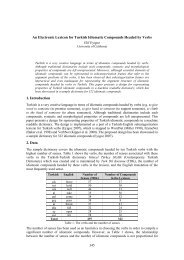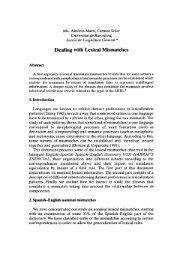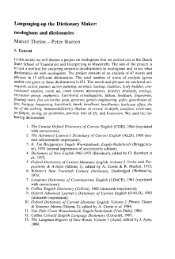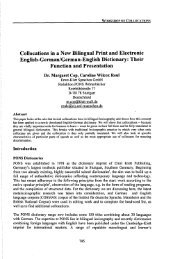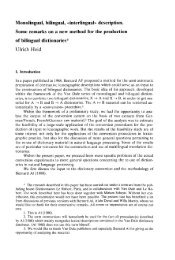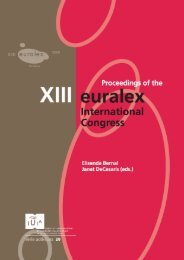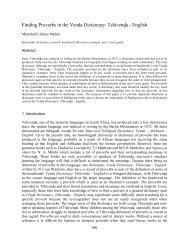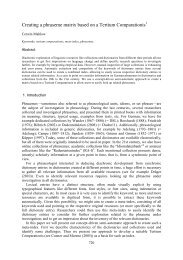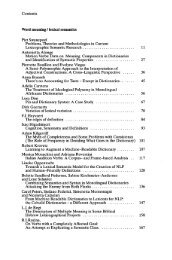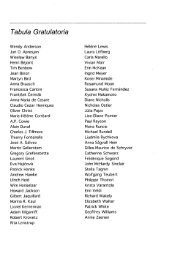Lexicon Creator: A Tool for Building Lexicons for Proofing ... - Euralex
Lexicon Creator: A Tool for Building Lexicons for Proofing ... - Euralex
Lexicon Creator: A Tool for Building Lexicons for Proofing ... - Euralex
Create successful ePaper yourself
Turn your PDF publications into a flip-book with our unique Google optimized e-Paper software.
T. Fontenelle, N. Cipollone, M. Daniels, I. Johnson<br />
possible correct <strong>for</strong>ms, which requires in-depth descriptions of the morphological rules of a<br />
language.<br />
<strong>Building</strong> full-<strong>for</strong>m lexicons<br />
Compared to many other languages, English has a relatively impoverished morphological<br />
system. Nouns typically <strong>for</strong>m their plurals by adding -s or -es (after a sibilant) and have a nearly<br />
non-existent case system, the genitive being the only remnant of such a system (the president’s<br />
decision). This means that a given noun normally has 4 distinct <strong>for</strong>ms (e.g. dog, dogs, dog’s,<br />
dogs’). Verbs traditionally have 4 or 5 distinct <strong>for</strong>ms (work, works, worked, working; eat, eats,<br />
eating, ate, eaten). It would be extremely time-consuming to list all these <strong>for</strong>ms and add them to<br />
the lexicon individually, which is why we have developed a tool, <strong>Lexicon</strong> <strong>Creator</strong>, that enables<br />
linguists to author the morphological rules of a given language and facilitates the generation of<br />
inflected <strong>for</strong>ms. <strong>Lexicon</strong> <strong>Creator</strong> allows linguists to classify variations of a given word into<br />
templates, which correspond to morphological classes. Once the templates have been defined,<br />
the data-coding process basically consists of associating a word to its correct template and<br />
checking that all the possible inflected <strong>for</strong>ms of this word are generated (and only these<br />
inflected <strong>for</strong>ms, if one wants to avoid overgeneration). If a template includes the rules that are<br />
necessary to create the distinct <strong>for</strong>ms of a verb like work (infinitive = base <strong>for</strong>m; 3 rd person<br />
singular = +s; past tense = +ed; present participle/gerund = +ing), it will then be sufficient to<br />
associate other verbs such as walk, talk, bark, crack… with the same template to automatically<br />
add inflected <strong>for</strong>ms such as walks, talked, barking or cracked to the lexicon, without having to<br />
manually list them.<br />
Authoring morphological rules<br />
<strong>Lexicon</strong> <strong>Creator</strong> provides a powerful authoring environment which enables the linguist to create<br />
sometimes very complex morphological rules, using regular expression patterns,<br />
character/string classes and functions which have made it possible to describe the inflectional<br />
system of over 40 languages, including Romance, Germanic, Scandinavian, Uralic, Semitic,<br />
African, Indic and Asian languages. Phenomena like gemination (En. big – bigger), vowel<br />
changes (Ge. Buch – Bücher), stem changes (Fr. venir – viens) can be expressed easily via<br />
functions which encode trans<strong>for</strong>mations consisting of patterns and replacements. Gemination of<br />
final consonants can be expressed as follows, <strong>for</strong> instance:<br />
Patterns appear to the left of the arrow and replacements appear to the right of the arrow.<br />
GeminateCons (e.g. travel travell):<br />
(.*)() (1)(2)(2)<br />
This function matches zero or more characters (.*) followed by a vowel and a consonant and<br />
returns the same initial sequence of characters followed by the same vowel followed by two<br />
occurrences of the consonant. has been defined as a string class consisting of all<br />
vowels. has been defined as a string class consisting of all geminating consonants<br />
(b, d, g, k, l, m, n, p, r, t).<br />
Once such a function has been defined, it can be used in writing the rules that can generate the<br />
inflected <strong>for</strong>ms that undergo gemination <strong>for</strong> a class of verbs that includes stop, blog, dot, flip…<br />
A rule which <strong>for</strong>ms the past tense would then look like this:<br />
(GeminateCons)ed<br />
which can be read as follows: the GeminateCons function applies to Stem #1 and the suffix “ed”<br />
is added to the output of that function. Assuming that the stem is stop, the intermediate<br />
geminated <strong>for</strong>m will be stopp and the final inflected <strong>for</strong>m generated by this rule will be stopped.<br />
The same function would be useful to create rules <strong>for</strong> adjectives that double their final<br />
consonant (big – bigger, dim – dimmer…). It will be used in English but also in languages like<br />
Dutch, where gemination is also fairly common (dun – dunner; kat – katten). It should also be<br />
noted that there need to be (at least) two distinct templates, one <strong>for</strong> words that cannot undergo<br />
360


